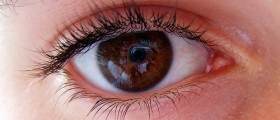
There are several eye problems that can lead to the onset of headache, including long sightedness, astigmatis, and the hardening of the lens of the eye. Most of these difficulties can be corrected through the use of prescription glasses or contact lenses. If the underlying cause of the eye problem is properly addressed, then it is likely that the headaches will cease to occur. I
n many cases, squinting and overworking the eye muscles can lead to the occurrence of headaches. Otherwise, internal pressure and swelling within the structures of the eye can transmit pain to other areas of the head. Some disorders of the eye might require medical investigation and prompt treatment.
The eye and its problems
After an image is passed through the initial layers of the eyes, it is eventually focused on the back of the eyes, also known as the retina. This part of the eye contains photosensitive cells known as rods and cones. Information is processed here in order to transmit shape, pattern and color to the brain. Focusing is undertaken using two structures, the cornea and the lens. Fine focus is undertaken by the lens, while the cornea deals with fixed focus.
In order to focus images properly, the cornea and the lens work together. Occasionally, there is an abnormality or interruption in the interplay of these two parts of the eye. This forces the eye muscles to work harder in order to compensate. As a result, the eyes might become tired or aching, and blurred vision and headache might thus occur.
Eye problems that are particularly associated with headache are astigmatism, hyperopia, and presbyopia. Astigmatism refers to a condition in which the cornea is irregularly shaped. This can lead to blurriness and subsequent squinting. Also known as long sightedness, hyperopia occurs when images are focused on a point behind the eye, rather than on the retina.
Presbyopia is a condition in which the lens becomes hard and inflexible. This is normally because of the aging process. Symptoms of this condition include sore eyes, difficulty in focusing, slower than normal focusing, and headache.
Glaucoma is another condition that can lead to severe headache. Glaucoma is caused by intraocular pressure. It is characterized by a build up of aqueous humor as a result of insufficient drainage. Glaucoma can lead to damage of the optic nerve. Early detection can slow the progression of glaucoma, but it is not a condition that can be prevented.

















Your thoughts on this
Loading...